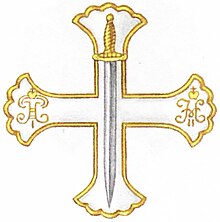Semyonovsky Bodyguard Regiment
The Semyonovsky Life Guard Regiment ( Russian Лейб-Гвардии Семёновский полк , Leib-Gwardii Semjonowski polk ) was a regiment of the Guard of the Imperial Russian Army that had existed since 1687 and provided personal protection for the Russian Tsar from 1700 to 1918 . Disbanded in 1918, it was re-established in 2013 as the 1st independent 'Semjonowski' rifle regiment .
history
Origin and first years

Tsar Peter I occupied from 1687 a Guards regiment , the village Semjonowskoje in Moscow for Sandbox - maneuver was stationed. The village was in the area of today's Moscow metro station Semenovskaya . From 1691 the regiment was named after the place as Semjonowski Regiment . In 1700 it was converted into one of the tsar's two bodyguard regiments alongside the Preobrazhensky regiment .
On November 30, 1700 the regiment lost 17 officers and 454 soldiers in the battle of Narva against the Swedes. The soldiers were allowed to wear red stockings from 1700 to 1740 as a reminder that they fought the battle knee-deep in blood. In 1702 the regiment took part in the 13-hour storming of the Schlüsselburg , for which the participants received a silver medal. On October 9, 1708 the regiment was thrown into the Battle of Lesnaya and on June 27, 1709 into the Battle of Poltava .
Napoleonic Wars
All three battalions of the regiment took part in the campaign of 1812 and were assigned to the 1st Brigade of the Guards Rifle Division of the 5th Infantry Corps. From Saint Petersburg 51 officers and 2,147 lower ranks marched out of the regiment. At the Battle of Borodino , the regiment was initially kept in reserve. After conquering the Rajewski ski jumps, the regiment was engaged in fighting to repel attacks by the French cuirassiers , which killed 120 of its soldiers. In the campaign of 1813 the regiment took part in the battles near Großgörschen , Bautzen , Kulm and Leipzig , and in 1814 in the battle of Paris .
Rebellion 1820
In the absence of Alexander I , who had left for the Troppau Prince’s Congress from October 20 to December 20, 1820, the guards of the Semyonovskoye Regiment refused to give orders to their commander Grigory Efimovich Schwarz on the evening of October 16, 1820 and were then taken to the Peter- and Paul Fortress arrested. Local authority lay with the Governor General of Saint Petersburg, Mikhail Miloradowitsch . On November 2, 1820, Alexander I issued a decree in Troppau , with which he dissolved the Semyonov regiment and had the soldiers divided between other army units.
From the start-up to the dissolution
In 1823 the unit was re-established. In 1905 he was used in the suppression of the uprising in Moscow .
During the First World War , the Semyonovskoye Regiment was deployed on the Southwest Front as part of the 1st Guard Infantry Division. A reserve battalion remained in Saint Petersburg, where it participated in the February 1917 Revolution . In March 1918, the Semenovskoye regiment returned from the front to Petrograd and was officially disbanded.
Under Nikolai Yudenitsch , part of the Semyonovskoye regiment fought the Red Army as a Northwest Volunteer Army until 1919 and was part of the White Army . The authorities of the Soviet Union charged some members of the Semyonov regiment with crimes related to the suppression of the 1905 uprising and were punished.
Individual evidence
- ↑ Lindsey Hughes: Russia in the Age of Peter the Great
- ↑ Archived copy ( Memento of the original dated December 14, 2010 in the Internet Archive ) Info: The archive link has been inserted automatically and has not yet been checked. Please check the original and archive link according to the instructions and then remove this notice.
